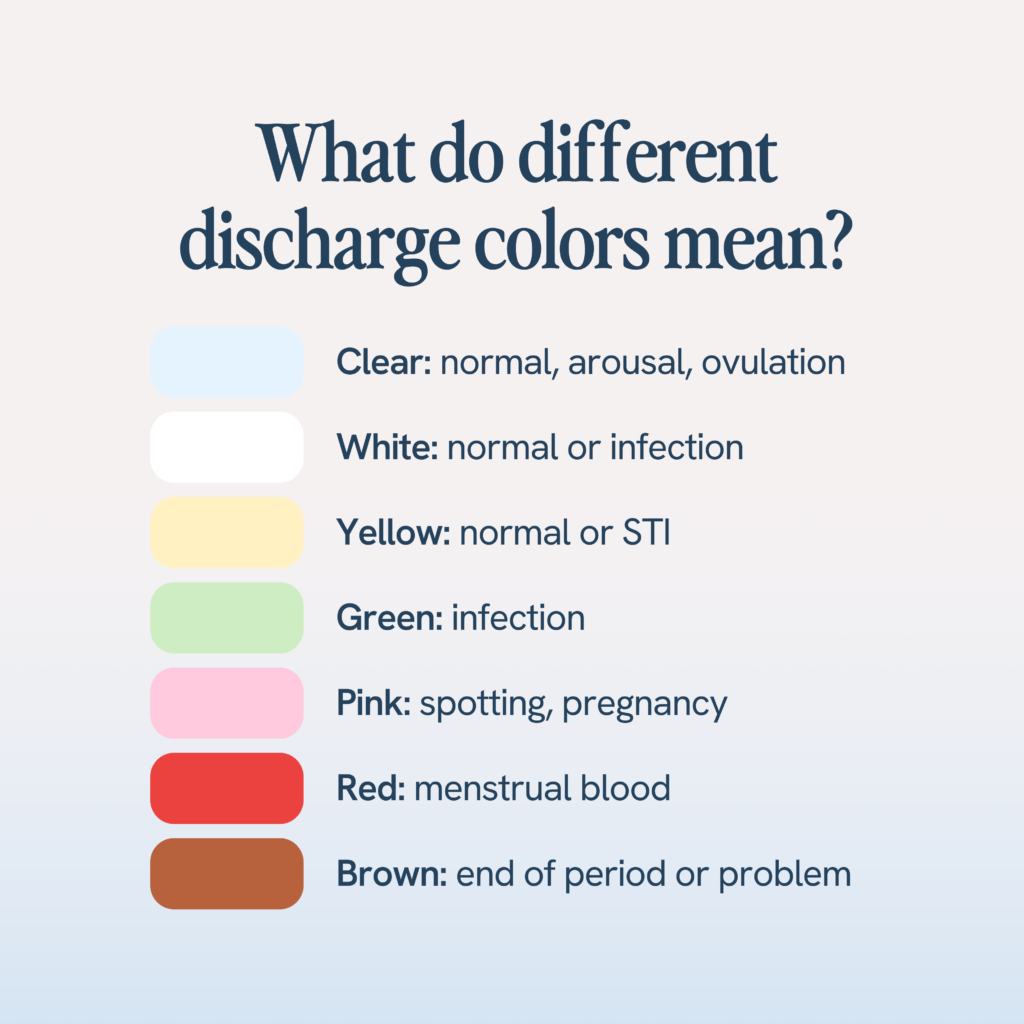- A change in your vaginal discharge color means your vagina is telling you something. Knowing the difference between normal discharge and atypical discharge can actually help you identify a yeast infection, a sexually transmitted infection like chlamydia, and even pregnancy!
- Unusual changes in consistency, like changing from thin to clumpy discharge, abnormal smells, and sudden changes in the color of discharge when combined can be an indication of a problem.
- If you’re experiencing a change in your regular discharge, pay close attention to foul odor, texture, vaginal itching, burning, and a change in color from clear to greenish—these are key indicators that you might have developed a vaginal infection or that you don’t have a healthy vagina.
Let’s face it, the vagina is pretty amazing. It creates life, gives us pleasure, and can clean itself. It can also tell us when it’s healthy or not feeling too well through vaginal discharge!
Vaginal discharge isn’t the most comfortable thing to think about. It’s probably something you don’t think about too often since it’s a part of everyday life, but knowing the difference between normal and abnormal discharge is your first indicator in recognizing if things like a yeast infection, a sexually transmitted infection, or even pregnancy are around the corner.
There are specific physiological and wellness factors that can change the color and consistency of your vaginal discharge, including the different times of the month. This blog serves as a one-stop shop to learn about the different vaginal discharge colors you can encounter.
So, let’s start with the basics.
What is Vaginal Discharge?

As you probably know firsthand, the vagina can secret fluids that we call vaginal discharge. It uses small glands in your vagina and cervix to remove harmful bacteria, dead cells, and debris from your vagina.
The primary purpose of vaginal discharge is to maintain the health and lubrication of the vaginal tract. This acidic vaginal discharge also helps to prevent infections like bacterial vaginosis (BV).
So consider healthy vaginal discharge to be a good thing.
What causes changes in Vaginal Discharge?

So many things can change the quantity, texture, and colors of your vaginal discharge that it’s important to acknowledge that change will happen throughout your life.
Normal life circumstances that can change your vaginal discharge include:
- Puberty
- Menstruation
- Pregnancy
- Peri, Menopause, and Post Menopause
- Sexual Relations
Some of the lifestyle influences include:
- Diet and hydration
- Exercise intensity
- Stress
And last, some of the things to look out for when things don’t seem as they should
- Bacterial Vaginosis
- Trichomoniasis
- Yeast Infections
- Other sexually transmitted infections or diseases
Does the color of my Vaginal Discharge matter?
In a healthy body, vaginal discharge helps to keep the vagina clean by naturally producing cervical fluid to help remove unwanted debris of harmful bacteria and dead skin cells. The change in one’s vaginal discharge can be a first sign that something is not working as it should.
It’s perfectly normal to have many different discharge colors, including pink, brown, or even black discharge! However, a recent study indicated that unusual changes in consistency, like changing from thin to clumpy discharge, abnormal smells, and sudden changes in discharge color when combined, can indicate a problem. (1) If you’re experiencing a change in your regular discharge, pay close attention to other indicates like foul odor, texture, vaginal itching, burning, and a change in color from clear to greenish, particularly if you’ve recently started having sexual intercourse with a new partner or changed your birth control method. These are key indicators that you might have developed a vaginal infection or don’t have a healthy vagina.
What do different vaginal discharge colors mean?

Clear Vaginal Discharge
Clear or clear to whitish vaginal discharge is what most would consider to be completely normal. This vaginal discharge hasn’t accumulated dead skin cells, bacteria, blood, or infection. If you experience clear discharge, it’s most likely due to normal secretion of vaginal fluids and sexual arousal.
Is Clear Vaginal Discharge An Early sign of pregnancy?
Yes, clear watery discharge can be an earlier indicator of pregnancy, as the cervix and vaginal wall soften and increase the production of vaginal fluids to prepare the body.
Is ovulation discharge clear?
Yes, during ovulation, the body creates more vaginal fluids making it more transparent and slippery. It creates more vaginal fluid in anticipation of sperm, making it easier for the sperm to reach the eggs for fertilization.
White Vaginal Discharge
White vaginal discharge typically means that you’re healthy. There are two types of very normal discharge. White vaginal discharge is normal and provides the necessary lubrication in your vagina. The cervix has glands that produce clear mucus. It is common for women to experience this type of white mucus discharge during times of sexual arousal, pregnancy, or ovulation.
Thin white discharge
A thin white discharge is something you may experience regularly. This kind of discharge can increase in amount if you are exercising more intensely or because you are sexually active.
Thick White Discharge
Thick white discharge. This is the kind of discharge you’ll typically notice when ovulating. However, if it is accompanied by a foul fishy odor, intense itching, or severe burning, you might have a BV infection or a vaginal yeast infection.
Thick White, Clumpy Discharge
Although considered normal vaginal discharge, you can have a yeast infection and still experience white discharge.
This type of discharge means you may have trouble maintaining healthy yeast levels in your vagina and experiencing yeast infections. Yeast infections are typically associated with an unusual smell and cottage cheese-like appearance; they may cause severe itching and burning and can make sexual intercourse painful.
To prevent frequent yeast infections and keep your vagina healthy, wear cotton underpants, avoid tight pants, and change your panty liner frequently. Speaking to your gynecologist is the best first step when you have signs of bacterial vaginosis or yeast infections.
- Yeast infections are treated with different antifungals such as Fluconazole, which can be inserted directly into the vagina or applied as a gel. (9)
White to Light Yellow Vaginal Discharge
A slight yellow discharge is considered normal and does not represent any serious problem. The little yellow discharge color can result from any change in your diet or hydration, or it could be richer in bacteria.
Dark Yellow to Green Vaginal Discharge
On the other hand, if you notice a vaginal discharge that is dark yellow or yellow-green, then it can be a sign of bacterial infection due to bacterial overgrowth or sexually transmitted infection. Moreover, if this yellow-green discharge feels thick or gooey-consistency with a foul odor, you should consult your healthcare provider.
Bacterial vaginosis, Trichomoniasis, Gonorrhea, and Chlamydia are the infections responsible for yellow to green-colored discharge. (4)
If you notice this kind of vaginal discharge alongside vaginal itching or redness, you should go to your ob-gyn for a diagnosis and treatment. In rare cases, yellow or green discharge could be a pelvic inflammatory disease (PID) symptom.
Gonorrhea and Chlamydia
Gonorrhea and chlamydia are commonly seen in sexually active women with multiple sex partners. Gonorrhea is caused by a bacterium called Neisseria, and the spread of Chlamydia trachomatis causes chlamydia. These infections result in a yellowish discharge, foul smell, and extreme burning. (6) These infections might also affect the cervix, so seeking medical care is important if you notice symptoms.
- Trichomoniasis is a sexually transmitted infection caused by Trichomonas vaginalis. It’s sometimes asymptomatic, but you could notice a yellow or green vaginal discharge when it does have symptoms. Trichomoniasis is a type of vaginal infection caused by the parasite Trichomonas vaginalis. (5) It can be spread from person to person through unprotected sex. Trichomoniasis is a parasitic condition that affects the vagina. Sharing towels or bathing suits can also lead to the transmission of the disease.
- About half of those who are affected show no signs of illness at all. People with this condition will frequently notice a yellow, green, or frothy discharge with a foul odor. Common symptoms include discomfort, itching, swelling in the vaginal region, and pelvic pain during urination or intercourse.
- Gonorrhea and Chlamydia are sexually transmitted infections. Both can result in yellow, foul-smelling discharge and a burning sensation. These infections might also affect the cervix. If you suspect having an STD, consult with your doctor. (4)
- Pelvic inflammatory disease (PID) is an infection of the female reproductive system, often resulting from untreated infections, such as gonorrhea or chlamydia. It’s accompanied by dull pain, irregular periods, or even fever. PID can damage your cervix, fallopian tubes, or ovaries and requires immediate attention.
Genital Herpes
This sexually transmitted infection (STI) can cause a foul-smelling, thick vaginal discharge, especially after sexual activity. A burning feeling when urinating, soreness around the genitals, and bleeding between periods are all symptoms of genital herpes.
But most people don’t have any or only mild symptoms. If you develop symptoms, you risk having recurrent episodes for the rest of your life.
Yellow-Green Discharge Without Odor
Green to Gray Vaginal Discharge
Green or grayish cloudy discharge accompanied by painful urination may indicate pus or an abscess in your vagina. While this can cause severe discomfort, it should resolve with antibiotic treatment.
A gray discharge can be a sign of bacterial vaginosis (BV), and it is not indicative of healthy discharge. The most common symptoms of BV include redness around the vulva, irritation, vaginal itching, and a strong foul odor.
Bacterial vaginosis (BV) comes with a vaginal discharge that has a fishy odor. The smell is usually more pungent after sex. You might also notice a change in your vaginal discharge’s color and consistency: it might look white to gray and be thinner than usual. BV can lead to other vaginal infections and Pelvic Inflammatory Discharge (PID), (2) so it should be treated immediately. Its clinical symptoms include increased pH, discharge with an unpleasant smell, and itching and burning sensations. (3)
- (BV) is usually caused by the overgrowth of harmful bacteria in your vagina, provoked by a pH imbalance or changes in your vaginal flora. If you’re using scented soaps or shampoos, if you have unprotected sex, or if you’re taking antibiotics, this could disturb the delicate balance of your vagina, which could then lead to bacterial vaginosis.
- Antibiotics are prescribed in cases of Bacterial Vaginosis (BV), Vaginitis, or other bacterial infections, which can lead to complications such as Pelvic Inflammatory Disease (PID) if left untreated. Common medications for treating such infections include Metronidazole and Clindamycin.
Pink Vaginal Discharge
Pink vaginal discharge means it contains a small amount of blood. It can also be light or darker pink, depending on the blood quantity. It is usually normal and occurs with spotting before a period.
You can also experience pink discharge during early pregnancy as a sign of implantation bleeding. Some women also experience a pink discharge after ovulation.
Another cause of pink discharge can be rough sexual intercourse. It happens because of a minor tear in your vagina or cervix during sex.
Red vaginal Discharge
Depending on the stage of your menstrual cycle, this type of discharge doesn’t indicate anything serious. If you’re in the middle of your period, you may have heavy flow, which causes red vaginal discharge.
Brown Vaginal Discharge
Usually, this type of discharge doesn’t indicate anything serious, depending on the stage of your menstrual cycle. For example, if your periods are about to end, you might see brownish spots, which is normal. It might mean you’re pregnant if you see red discharge or spots instead of having your periods on time. Unfortunately, if you’re already pregnant and experience red or brownish discharge, it means you’re having a miscarriage. In very rare cases, the red or brownish discharge might indicate Pelvic Inflammatory Disorder (PID), or you’re developing cancer in your ovaries or cervix; therefore, the quality and colors of your discharge must be checked regularly!
- Unfortunately, red or brown discharge can also signify a serious medical condition. If you are already pregnant and notice red or brownish discharge, you may have a miscarriage. Rarely, red or brownish discharge might indicate PID or ovarian or cervical cancer. (7)
- Every healthy woman experiences menstrual bleeding around every 28 days on average. It is expected during the menstrual cycle. A period typically lasts for 3 to 5 days. If you are experiencing vaginal bleeding after one year after menopause, it can be a sign of endometrial cancer, and you should see a healthcare professional immediately for medical advice.
- Does brown discharge mean pregnancy
4.4K
Although it might be worrying, red or brown discharge during pregnancy is sometimes expected due to all the hormonal changes your body is going through. It isn’t necessarily a sign of miscarriage. Contact your doctor immediately if you notice other symptoms (such as dizziness, abdominal pain, or contractions). (5)
- Red or brownish – Normally, this type of discharge doesn’t indicate anything serious, depending on the stage of your menstrual cycle. For example, if your periods are about to end, you might see brownish spots, which is normal. It might mean you’re pregnant if you see red discharge or spots instead of having your periods on time. Unfortunately, if you’re already pregnant and experience red or brownish discharge, it means you’re having a miscarriage. In very rare cases, the red or brownish discharge might indicate Pelvic Inflammatory Disorder (PID), or you’re developing cancer in your ovaries or cervix; therefore, the quality and colors of your discharge must be checked regularly!
How does vaginal discharge change during your life?

Vaginal discharge changes during your life, especially with the usual hormonal levels variations accompanying puberty, adulthood, pregnancy, and menopause.
Vaginal discharge first appears around the girl’s first period but can be already present for up to six months before that. After that, your body goes through a regular vaginal discharge cycle (see the next question for more information). During the different stages of your monthly menstrual cycle, your vaginal discharge will naturally vary from thick to thin, almost absent to abundant, and sticky to non-sticky. Pink or brown vaginal discharge is expected before or after your period. However, you should speak to your doctor if you notice it between periods.
Vaginal discharge during pregnancy can be different than before: due to hormonal changes, your cervix might produce more mucus than usual. Spotting and brown or red vaginal discharge isn’t unusual for some women, especially in the first trimester. Still, you must urgently receive medical care if they’re accompanied by abdominal pain or contractions.
After menopause, estrogen levels drop, leading to a pronounced decrease in vaginal discharge. For that reason, women often experience vaginal dryness after menopause, and intercourse can become painful. Vaginal moisturizers, lubricants, or estrogen creams can be prescribed to treat post-menopausal vaginal dryness.
How To Keep Your Vagina Clean and Avoid Abnormal Vaginal Discharge

You are wondering how to keep your vagina happy and avoid vaginal infections? With a few simple tips, you can prevent unusual discharge and maintain the health of your vagina.
- Avoid using scented creams or soaps in your vagina. Using chemically infused products can disrupt normal pH levels, allowing harmful bacteria to overgrow good bacteria. Don’t use scented creams or products such as soaps on your sensitive part because they disrupt the average PH level, allowing harmful bacteria to overgrow good bacteria.
- Do not overuse vaginal cleansers; remember, your vagina can already clean itself. Instead, use a soft loofah to gently exfoliate the external area, known as the vulva, with water.
- Don’t use vaginal douches regularly because your vagina can already clean itself. You can use a soft loofah to exfoliate the external area (vulva) with water gently.
- Use protection when you have sex, and avoid having multiple sexual partners. Don’t be afraid to have open conversations with your partner about any unusual symptoms you experience to avoid getting or spreading infections. Remember, as a couple, you are in this together! If you wish to save yourself from multiple infections, smelly discharge, itching, and other problems, have protected sex and avoid having multiple sex partners.
- Add Greek yogurt to your diet to support good bacteria in your vagina. If you do not like yogurt, replace it with a prebiotic and probiotic for vaginal health. Both yogurt and probiotic supplements help re-establish the balance between harmful and good bacteria, supporting gut and vaginal health. Add natural yogurt to your diet, and if you’re not a big fan of yogurt, you can replace it with probiotic and prebiotic supplements. Yogurt and probiotic supplements help re-establish the balance between harmful and good bacteria.
- Always change into dry, clean clothes immediately after exercising or swimming. Staying in wet clothing helps infection-causing bacteria grow. The same goes for your underwear—keep your undergarments light and airy. Tight, moist environments support the growth of harmful bacteria. Always change your clothes immediately after an exercise or a swimming session because it provides optimal conditions for the growth of infection-causing bacteria.
- If you experience any symptoms, such as itching, burning, or pain, in combination with an unusual discharge, consult your doctor. (8)
Leaving a tampon for too long in your vagina can also provoke an unusual vaginal discharge and a foul smell, so always take out tampons after a couple of hours. If you suspect you might have forgotten a tampon inside, try to pull it out yourself. If you don’t manage to do that, your doctor will help—and it happens incredibly often, so there’s no reason to be embarrassed. A piece of a broken condom might also provoke an unusual discharge and need removal.
Our Happy V® Prebiotic + Probiotic was created for anyone who is experiencing symptoms related to Bacterial Vaginosis and Yeast Infections. Eliminate the odor, itch, gut bloating, and other symptoms.
What are signs I need to see a healthcare provider concerning unusual discharge?
If you notice atypical discharge, discussing it with your healthcare provider is essential. Your provider will start by determining what type of infection you have through a physical examination of the vaginal discharge. Your doctor will ask you questions about its color and smell and whether it itches, burns, or is associated with any other strange symptoms, like abdominal pain or pain with urination. Depending on your answers, a culture may be taken to identify the culprit.
- Yeast infections can be treated with different antifungal medications such as Fluconazole. These may be inserted directly into the vagina or applied in the form of a gel.
- Antibiotics are prescribed for BV, vaginitis, or other bacterial infections, which can lead to complications such as PID if left untreated. Common medications for treating such infections include Metronidazole and Clindamycin.
Knowing the Difference Between Healthy Discharge and Abnormal Discharge Can Help You Have a Happy V
We can’t say it enough—the human body is fantastic. The colors and textures of your vaginal discharge are your vagina’s way of telling you what’s happening in your body. These colors and symptoms might vary from person to person, so it’s important to pay close attention to your body and learn what’s normal for you.
-
- WebMD, How should you clean your vagina. https://teens.webmd.com/girls/qa/how-should-you-clean-your-vagina
- Eschenbach, D. A., Hillier, S., Critchlow, C., Stevens, C., DeRouen, T., & Holmes, K. K. (1988). Diagnosis and clinical manifestations of bacterial vaginosis. American journal of obstetrics and gynecology, 158(4), 819-828.
- Mayoclinic, Vaginal Yeast Infections. https://www.mayoclinic.org/diseases-conditions/yeast-infection/symptoms-causes/syc-20378999
- Shapiro, R. A., Schubert, C. J., & Myers, P. A. (1993). Vaginal discharge indicates gonorrhea and Chlamydia infection in girls under 12 years old. Pediatric emergency care, 9(6), 341-345.
- Centers for Disease Control and Prevention, Diseases characterized by vaginal discharge. https://www.cdc.gov/std/tg2015/vaginal-discharge.htm
- WebMD, Vaginal discharge—What’s abnormal?. https://www.webmd.com/women/guide/vaginal-discharge-whats-abnormal#1
- Al Quaiz, J. M. (2000). Patients with vaginal discharge: A survey in a university primary care clinic in Riyadh city. Annals of Saudi Medicine, 20(3-4), 302-306.
- WHO, Guidelines for the management of sexually transmitted infections. https://apps.who.int/medicinedocs/en/d/Jh2942e/3.4.2.html
- Centers for Disease Control and Prevention, Vulvovaginal Candidiasis. https://www.cdc.gov/std/tg2015/candidiasis.html
- Centers for Disease Control and Prevention, Bacterial Vaginosis. https://www.cdc.gov/std/tg2015/bv.htm
- Krasnopolsky, V. N., Prilepskaya, V. N., Polatti, F., Zarochentseva, N. V., Bayramova, G. R., Caserini, M., & Palmieri, R. (2013). Efficacy of vitamin C vaginal tablets as prophylaxis for recurrent bacterial vaginosis: a randomized, double-blind, placebo-controlled clinical trial. Journal of Clinical Medicine Research, 5(4), 309.
- Genet, J. (1995). Natural remedies for vaginal infections. SIDAhora: un proyecto del Departamento de Publicaciones del PWA Coalition, NY, 40.
- Krasnopolsky, V. N., Prilepskaya, V. N., Polatti, F., Zarochentseva, N. V., Bayramova, G. R., Caserini, M., & Palmieri, R. (2013). Efficacy of vitamin C vaginal tablets as prophylaxis for recurrent bacterial vaginosis: a randomized, double-blind, placebo-controlled clinical trial. Journal of Clinical Medicine Research, 5(4), 309.
- Genet, J. (1995). Natural remedies for vaginal infections. SIDAhora: un proyecto del Departamento de Publicaciones del PWA Coalition, NY, 40.
Women who used Happy V Pre+Pro experienced improvements in their vaginal health.*
- A-
- A+
Women who used Happy V Pre+Pro experienced improvements in their vaginal health.*






